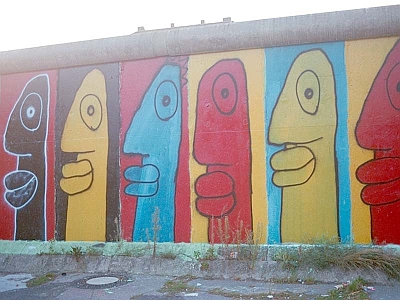Today is it 30 years since the fall. Do you appreciate your freedom?

PainterThierry Noir. Photo licens: Kilometer Kunst Bethaniendamm, Berlin Kreuzberg, 1986. Author de:Benutzer:Noir. https://commons.wikimedia.org/w/index.php?title=File:Thierry-Noir-Bethaniendamm04.jpg
“Thierry Noir is a French artist who is claimed to be the first street artist to paint the Berlin Wall.[1] His brightly colored paintings, which often feature cartoon-like profiles, are now considered iconic and can still be seen on the East Side Gallery. He currently lives and works in Berlin, Germany.[2]. In April 1984, Noir and Christophe-Emmanuel Bouchet started to paint the Berlin Wall, eventually painting 1 kilometre of it.[6] Initially, the attitude of West Berliners to Noir’s work was wary, often even hostile. Some believed that he was working for budget money and were against such spending of money from his taxes. Others believed that Tieri’s task was to make a more “presentable” wall, which they could not agree with.[5]”
https://en.wikipedia.org/wiki/Thierry_Noir
What is the cultural legacy of the fall of the Wall?
The Berlin Wall (German: Berliner Mauer, pronounced [bɛʁˈliːnɐ ˈmaʊ̯ɐ] (About this soundlisten)) was a guarded concrete barrier that physically and ideologically divided Berlin from 1961 to 1989.[1] Construction of the Wall was commenced by the German Democratic Republic (GDR, East Germany) on 13 August 1961. …For many years after reunification, people in Germany talked about cultural differences between East and West Germans (colloquially Ossis and Wessis), sometimes described as Mauer im Kopf (The wall in the head). A September 2004 poll found that 25 percent of West Germans and 12 percent of East Germans wished that East and West should be separated again by a “Wall”. (Wikipedia Berlin Wall)
https://en.wikipedia.org/wiki/Berlin_Wall
The fall of the Berlin Wall in 1989 would send out new shock waves as a start to globalization later with the new media corporations succeeding military colonization. During the 1980s, transnational companies mainly expanded from the United States, which went hand in hand with the spread of neoliberalism (Fulcher & Scott 2011: 383).
Exhibition at the National Museum Stockholm: 1989 – culture and politics
“This fall’s exhibition at the National Museum revolves around one of history’s most dramatic moments, the fall of the Berlin Wall in 1989.… The exhibition includes documentary photos, portraits, posters, video and design by artists, photographers and designers such as Richard Avedon, Ron Arad, Cecilia Edefalk, Nan Goldin, Willliam Kentridge, Barbara Kruger, Boris Mikhailov, Tracey Moffatt, Ingrid Orfali, Ingegerd Råman, Philippe Starck, Lars Tunbjörk, Pia Wallén and Andres Serrano. … The political upheavals in Eastern Europe continued during the following years. Free elections were held in a number of countries, the two German states reunited on October 3, 1990, and the Soviet Union disbanded at the end of 1991. In Yugoslavia, the development following the collapse of communism led to a protracted war. ”
https://www.nationalmuseum.se/utst%C3%A4llningar/1989-kultur-och-politik
In a radio program “Europapodden” about the fall of the wall the question arises if many does not appreciate their freedom in Germany? The middle of the politic parties has been weakened? Many people are not longer feeling they are represented by the establishment?
Många uppskattar inte sin frihet (SR 5 Nov 2019) https://sverigesradio.se/sida/avsnitt/1388164?programid=4941
European policy is being pushed further and further towards the outer edges as professor Stefan Hedlund writes? Is it a choice between the neoliberalism and the nationalism? ”Europeisk politik drivs allt längre ut mot ytterkanterna” (2017 SVD)
https://www.svd.se/europeisk-politik-drivs-allt-langre-ut-mot-ytterkanterna
Another artist who invites spectators on the changes in postwar Berlin is Shimon Natti, who creates works in his series “Writings on the wall” (1991-2) through video projection of old archival photos with motifs of dynamic Jewish folk life before the Holocaust that Nattie projects to the downtrodden. buildings in the old Jewish Quarter as a juxtaposition. Many parts of Berlin are still abandoned since the war when large parts were bombed. Here are reactions from the non-Jewish residents who feel that they are accused either of being profiteers of the extermination of the Jews or of being accused of being Jews themselves, which perhaps shows that this has not changed much?
(Kalb 2013: 150).
Artist Shimon Natti projekt page
http://shimonattie.net/portfolio/the-writing-on-the-wall/
Human Right Watch: Germans Reflect on 30 Years Since Fall of Berlin Wall
“The debates this week also show that Germany still faces many human rights problems. Human Rights Watch’s annual review lists attacks on migrants, xenophobia, and anti-semitism among such concerns. Yet unity means Germans, wherever they live, have for 30 years been able to rely on state institutions, built on the rule of law, to tackle such problems. That is an achievement – and one worth celebrating.” https://www.hrw.org/news/2019/11/04/germans-reflect-30-years-fall-berlin-wall
///// Sources and more art history reading about the Berlin Wall:
Kalb R. Peter (2013), Art since 1980: Charting the contemporary, Laurence King Publishing:
London.
Khan Academy
https://www.khanacademy.org/humanities/art-1010/architecture-20c/a/the-berlin-wall-as-a-political-symbol-edit
Fulcher James & John Scott (2011), Sociology, Oxford University Press: Oxford
List of Berlin Wall Segments (art works)
https://en.wikipedia.org/wiki/List_of_Berlin_Wall_segments
Piece of Berlin Wall, a gift of Germany, unveiled at UN garden (2002)
https://news.un.org/en/story/2002/04/31462-piece-berlin-wall-gift-germany-unveiled-un-garden
Många uppskattar inte sin frihet (5 Nov 2019)
https://sverigesradio.se/sida/avsnitt/1388164?programid=4941
/////////////////////////////
